Local advertising is an effective way to boost brand awareness and attract customers in a specific locale. It allows you to target nearby prospects based on the audience of the medium used (e.g., newspapers or radio stations) or to use ad targeting tools to put your advertisements directly in front of your ideal customers. With that in mind, here are 27 local advertising ideas you can use to grow your small business.
Local advertising is any form of advertising that is geographically targeted to a specific area—the local market for a business’ goods or services. This type of advertising takes many forms, including display advertising on billboards and buses, print advertising like newspaper ads and direct mail, and online advertising with sites like Google and Facebook.
1. Get Free Local Advertising in Online Business Directories
Average cost: Free
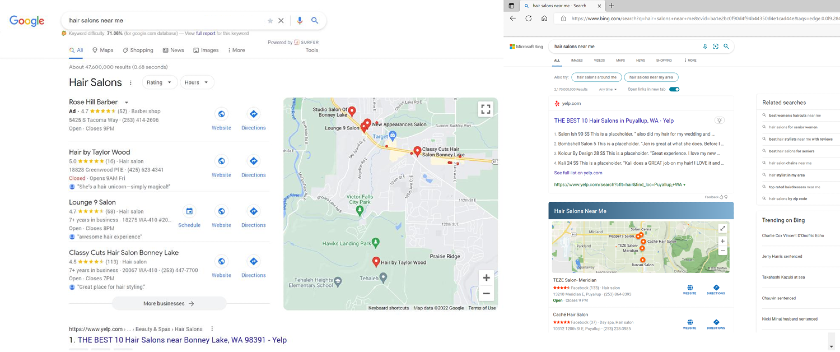
Your listings can appear in online directories when people search for a business “near me.”

Pros
- More ways to get found in local searches online
- Improves your website’s search engine optimization (SEO)
- Another source of website traffic
- Most directories are free to list in
Cons
- Can be time-consuming to submit, monitor, and edit listings if you have a lot of listings to manage
Best For
- Any type of local business
- Retail, service-based, restaurants, and travel or tourism-dependent businesses
Adding a listing for your business to online business directories is a vital part of your local marketing plan. It offers another place for local patrons to discover your business (in the actual directory) and benefits your website’s search engine optimization (SEO), helping your site rank higher in local search results.
At a minimum, your local advertising strategy should include adding the following listings:
- Google Business Profile (formerly Google My Business)
- Facebook (business profile)
- Bing for Business
- Yelp for Business
- Angi (formerly Angie’s List) for service-based businesses
This gives you a good start at increasing your brand’s online visibility and a solid foundation to advertise locally online. From there, add your business listings to some of the best online directories that make sense for your company or industry. Then monitor your brand’s listings and reputation using a platform like BrightLocal to ensure your listings remain accurate across the internet.
While you’re building your local profiles, pay close attention to the categories you select for your Google Business Profile. You can choose up to nine categories, but BrightLocal research indicates most businesses use no more than five categories. For example, if you’re a general contractor, your primary category would be general contractors, while four additional categories could be home improvement, remodeling, home repair, and insurance restoration.
2. Turn Customers Into Advocates With a Referral Program
Average cost: $45 to $100 per month
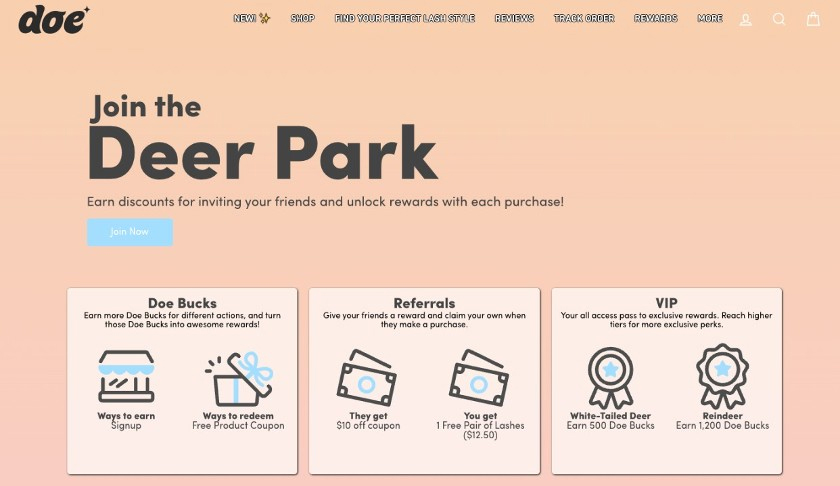
An example of local business advertising through referral rewards.

Pros
- Rewards customers for word-of-mouth marketing
- Improves customer retention
- Generates new business
- An affordable local advertising idea
- Software makes it easy to manage
Cons
- May take time for customers to adopt
- Incentives may not be rewarding enough to work
- Referrals might not match your ideal customer type
Best For
- Service-based businesses
- Retail stores
- Restaurants and coffee houses
- Online retailers
Everyone loves a discount, freebies, or other small rewards—especially from a local company they already love. Referral rewards programs turn your customers into brand advocates by incentivizing them to spread the word about your business. This is one of the local business advertising ideas that can have a huge return on investment (ROI).
Plus, loyalty and rewards software make your program easy to set up and manage, making word-of-mouth marketing a win-win for you and your fans. For more inspiration, check out our list of loyalty program ideas and examples.
Interested in more referral marketing ideas? Find out more about how to get referrals to gain new customers.
3. Increase Retention & Revenue With Loyalty Rewards
Average cost: $45 to $100 per month
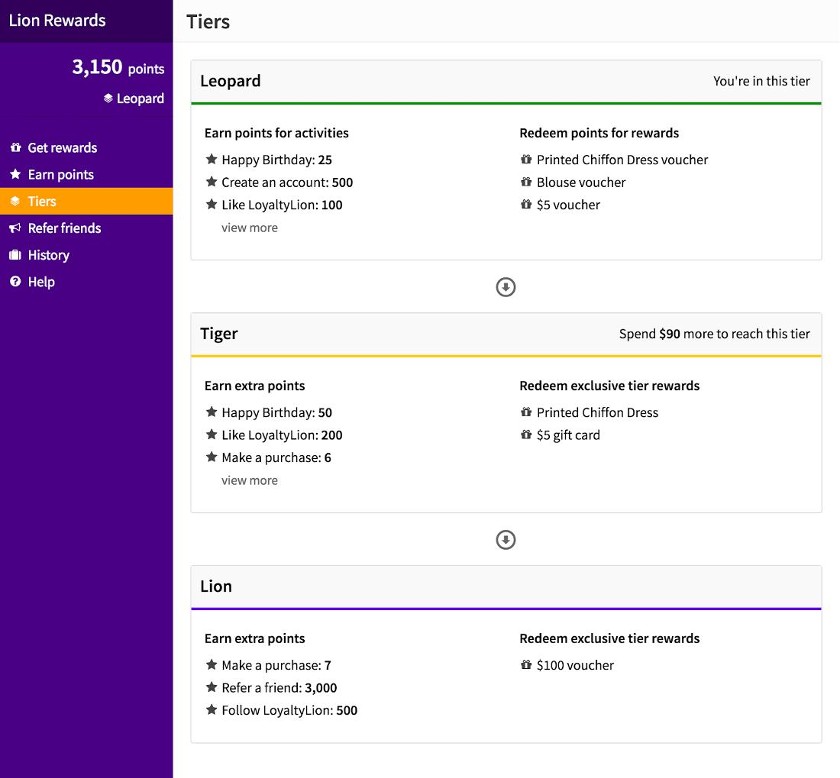
Example of a tiered loyalty rewards program from LoyaltyLion on Pinterest

Pros
- Brings customers back more frequently
- Incentivizes referrals and reviews
- Reinforces customer loyalty
- Can be gamified for more engagement
- Generates retail sales for service-based businesses like salons
- Increases average revenue per salon
Cons
- Some expense to manage in terms of software and value of rewards
Best For
- Retail businesses
- Restaurants
- Service businesses like spas and salons
- Ecommerce businesses
Customer loyalty programs can help small businesses retain current clients and turn new buyers into repeat customers over the long term. Customers who feel valued are far more likely to purchase more frequently—and as with rewards programs, using software makes it easy to manage. Check out our list of the best customer loyalty program software you can use to encourage customer retention and drive sales.
4. Get Brand Exposure With Local Press Coverage
Average cost: From free to $250
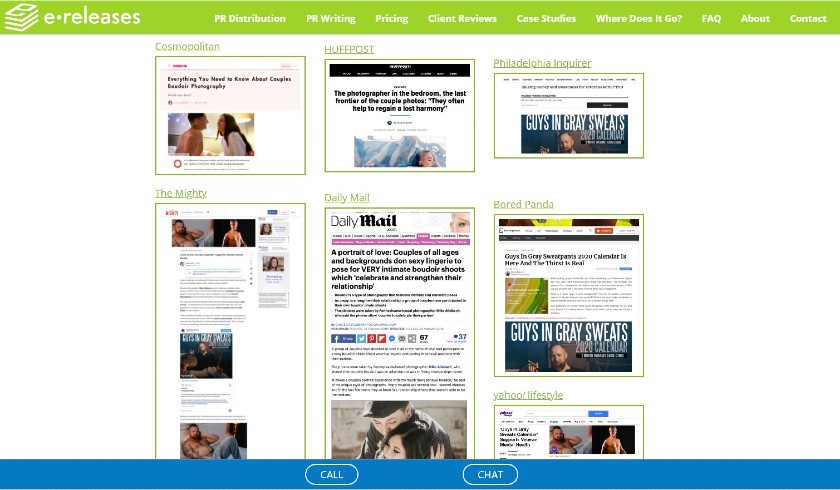
Write and publish yourself or get press release writing and distribution through a provider like eReleases.

Pros
- Ability to target specific audiences
- Some providers email your release directly to journalists
- Ability to land free local advertising on TV, radio, in newspapers, and online publications
Cons
- Can be expensive
- No guarantee of getting additional coverage
Best For
- Increasing brand awareness and finding new customers
- Informing the local public about your news and events
- Announcing changes to your business or new locations
Getting local press coverage can be a huge boon for a small business, whether your story ends up in the newspaper or lands a local TV news spot. If your press release is newsworthy, the media coverage you garner can quickly get the word out about your business to local audiences.
Ready to write your first press release?
- Learn what a press release is and how it works
- Learn how to write a press release step by step with our free template
- Make sure you know what makes a good press release
- Use our top-recommended press release writing services to increase your chances of getting coverage
- Use one of the best press release distribution services to get guaranteed syndication
5. Increase Local Visibility With Billboard Ads
Average cost: From $10 a day for digital or $600 to $3,000 per month for physical billboards
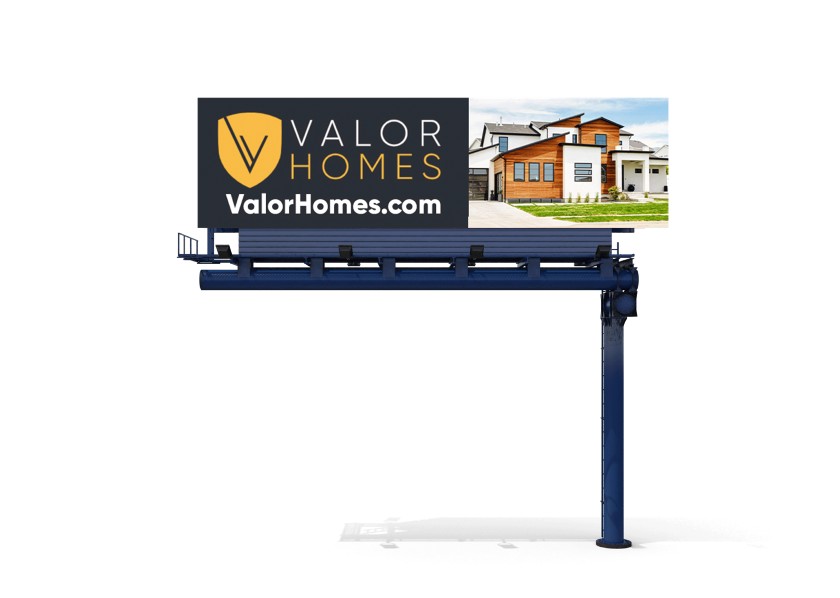
Billboard ads let you reach local customers on the go. (Source: Blip Billboards)

Pros
- Great for brand awareness
- Creates first impressions for new businesses
- Can be affordable, especially for digital billboard ads
Cons
- Depending on the local market, can be pricey
Best For
- Any type of small business
- Announcing new locations
- Advertising sales and promotions
It isn’t uncommon to dream of having your small business advertised on a billboard above a busy street or freeway. But if your local business advertising hadn’t included billboards before because you thought they were too expensive, you might want to think again. Find out how much billboards cost in various cities—both physical and digital billboards.
Billboard advertising is surprisingly affordable, especially when you choose digital billboards through a platform like Blip Billboards, which works for budgets as low as $10 a day. If you’re ready to get started, get some local advertising ideas for your billboards from our list of must-see billboard designs.
6. Land at the Top of Google Search Results With Local Ads
Average cost: $2 to $6 per click
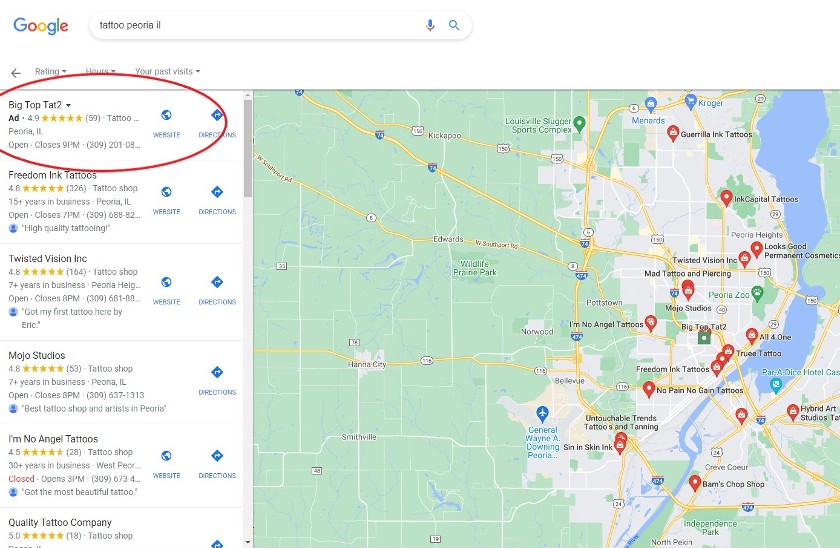
Local search ads appear above organic results in online search.

Pros
- Drive traffic to your website and to the doors of your business
- Ads appear only in local searches
- Target your audience with specific keywords
- Fits almost any budget
Cons
- Can get expensive
- Requires a bit of SEO knowledge
Best For
- Advertising any local business
- Getting brand awareness for a new business
- Advertising special promotions
- Getting above competitors in results
Take control over your small business website’s position in local search results by setting up Google local service ads. Even new businesses can appear at the top of results when they use pay-per-click (PPC) advertising on Google.
It’s one of the local advertising ideas that affords a lot of control over your budget, as you can turn your ads on or off depending on when you have the budget to run ads. Google ads can be surprisingly affordable, especially for low-competition keywords. Learn more about how to advertise on Google.
7. Set Your Website Up for Local Advertising Success
Average cost: $12 to $40 per month
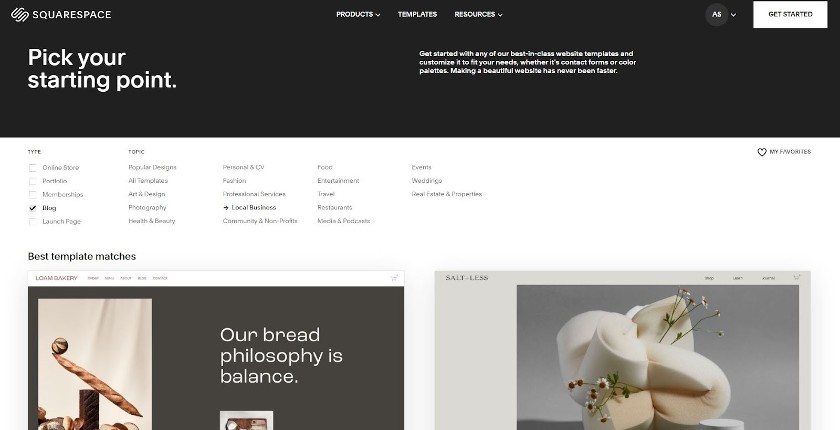
Easily create landing pages for your local advertising ideas to maximize conversions with a site builder like Squarespace.

Pros
- Dedicated landing pages increase conversions
- Ability to extend offers or generate subscriptions with pop-ups and splash pages
- Can sell online to increase revenue
- Improve customer retention with online loyalty, rewards programs, and exclusive content
Cons
- Requires investment of time and budget
Best For
- Any small business that wants to build their brand presence online
- Providing store information 24/7
- Enhancing customer support
- Dedicated ad landing pages
- Adding ecommerce to your store
- Accepting reservations or selling memberships
To get the most out of all the other local advertising ideas you’re implementing, you need a great-looking website that provides a positive user experience (UX) at the hub. Make sure your landing pages closely match the ads and keywords used in your social media and email campaigns. Using the same keywords will ensure that your content is relevant and provides a unified experience to your site visitors. Learn more about creating the best UX by checking out our examples of the best landing pages.
Squarespace is an all-in-one website builder that will save you time, and it includes everything you need to get a professional site up quickly. Squarespace is a great choice for any project (and one of our top picks for the best website builders for SEO for small businesses).
8. Rank in Search Organically With Local SEO
Average cost: $29 per month
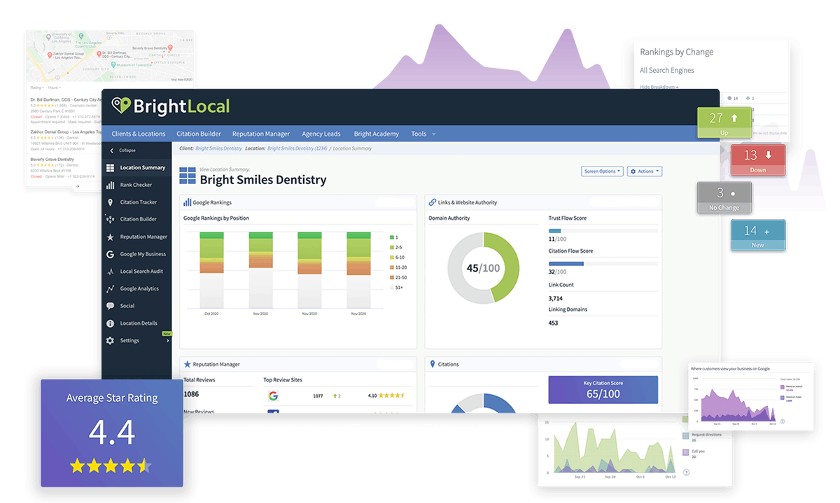
An example of a BrightLocal dashboard monitoring local SEO efforts

Pros
- Many local SEO tactics are free
- Drive traffic to your website by getting found in Google
- Turns your website into a marketing tool for your business
Cons
- Long-term strategy that can take months
- Involves some SEO know-how (or the time to learn)
- A lot of potential tactics to use, so it can be time-consuming
Best For
- Any local business
- Businesses with a physical location
- Businesses that serve a particular area
Many people skip the ads in local search results and opt to click on organic results instead, which is why it’s important to invest in local search engine optimization (SEO). To do this, you’ll need to optimize your website for local search, get reviews on Google, and engage in local content marketing.
Local SEO includes a number of tactics and can require a significant investment of time. To help you better understand what’s involved and find resources to help, here are some guides to check out:
- What local SEO is and how to rank higher in local online search results
- What an SEO content marketing plan is and how to implement one
- Using the best keyword research tools, like the free tool Semrush, for researching keywords and tracking your rankings
- Best tools for local SEO
- Save time and get expert help with affordable local SEO services
9. Run Local Newspaper Ads
Average cost: $50 to $2,700
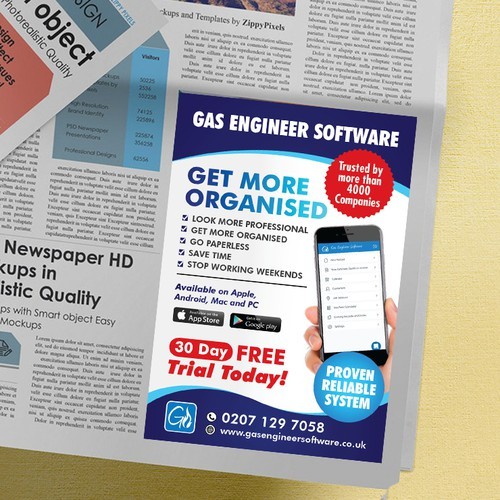
An example of small business advertising in newspapers (Source: 99designs)

Pros
- Affordable, depending on ad size and city
- Ability to get exposure in both print and digital versions
- Great option for coupon marketing
- Gain new customers and boost local brand awareness
Cons
- Can be pricey in some locations
- Newspaper circulation is decreasing (24.3 million weekdays)
Best For
- Local brick-and-mortar shops
- Service-based businesses
- Reaching an older demographic
- Print coupon marketing to bring in new customers
Advertising in your local newspaper offers enormous benefits, especially if your target audience reads newspapers every day. Depending on where you live, the cost of newspaper ads can be affordable or expensive. Cost also varies based on the size of the ad you run. However, proceed with care, as local small business advertising in newspapers can become expensive quickly.
Consider hiring a professional designer from Fiverr to design your ad so it stands out. That’s affordable too, with graphic design services starting at $5. Learn more about its functionalities in our Fiverr review.
Alternatively, you can source multiple designs by holding a contest on 99designs to find a designer to work with who truly understands your brand and its style. Check out their website to earn more about how it works.
10. Catch the Attention of Commuters With Radio Ads
Average cost: $200 per 30-second spot

Radio ads are an effective way to reach out to local customers and the community.

Pros
- Reach a broad local audience
- Advertise on local stations that match your ideal customer’s demographics
- Choose ad spot length (e.g., 15, 30, 60 seconds) based on your budget
- Affordable, depending on your market, peak or non-peak time slots, and ad size
Cons
- Can be pricey in larger metro areas
- Not as targetable as Google Ads or Facebook advertising
Best For
- Growing brand awareness
- Reaching a particular demographic
- Attracting a new audience
- Advertising promotions or specials
Although radio has lost listeners to streaming services, more than 156 million people in the U.S. listen to the radio every day. That’s a convincing reason to consider using radio for local advertising. Also, the cost of radio ads is reasonably affordable, with smaller markets offering 30-second spots for about $50.
Read more about how to advertise on radio for your local audience. When you’re ready, consider hiring a Fiverr radio advertising pro to write your ad or even record it.
11. Create a Geotag for Social Media Tagging
Average cost: Free

Create a geotag for your business’ location on Facebook in your business’ page settings.

Pros
- It’s free to create a geotag
- Boosts your visibility on social media
- Complements local hashtags (use your city or region)
Cons
- Some users don’t geotag to preserve privacy
Best For
- Any business with a physical location for customers
- Hotels
- Restaurants
- Entertainment spots (escape rooms, arcades, theaters, bars, and so on)
- Event destinations like wedding venues and concert halls
- Recreational businesses like zoos, camping sites, and vacation rentals
Creating a geotag for your business’ physical location is a great way to earn new customers. A geotag is a location tag—like a pin on a map—on social media.
Platforms like Snapchat, Facebook, and Instagram make it easy for you to tag your business in posts. You should do this in conjunction with hashtags that target your location so people searching #newyorkcity, for example, might come across your posts.
Geotagging is great for restaurants, hotels, entertainment venues, marketing a bar or nightclub, and real estate businesses too. You can also incentivize customers to give you a shout-out with a geotag while at your business through rewards programs, or simply by encouraging them to do so on signs inside your facility.
12. Use Facebook Ads Intuitively
Average cost: $2 per click

An example of locally targeted Facebook ads

Pros
- Fairly affordable, providing the ability to control budget
- Advanced targeting to maximize your return on ad spend (ROAS)
- Good way to increase local brand awareness and get visitors to your website or store
Cons
- Can get expensive
- Learning curve to master all the possible targeting and ad type options
- Brand awareness won’t necessarily lead to sales
Best For
- Online and brick-and-mortar local businesses
- Service-based businesses
- Generating interest from targeted audiences
- Creating brand awareness for new businesses
- Customer engagement and interaction
To use Facebook ads for local advertising effectively, you need to know precisely what your goal is for your ads. For example, your ad should include a link to a dedicated landing page if you want to drive traffic to your website. If you intend to get social followers or email subscribers, your ad should specify exactly the action you want viewers to take. Also, eye-catching images and videos are essential if you want your ads to get noticed.
There are 2.93 billion Facebook users worldwide as of the first quarter of 2022, so it’s a large audience overall. However, your costs can vary depending on the type of ad, your audience, and your industry. Find out how much Facebook ads cost based on audience, bidding, and competition.
13. Sponsor Something Important to the Local Community
Average cost: $150 to $500
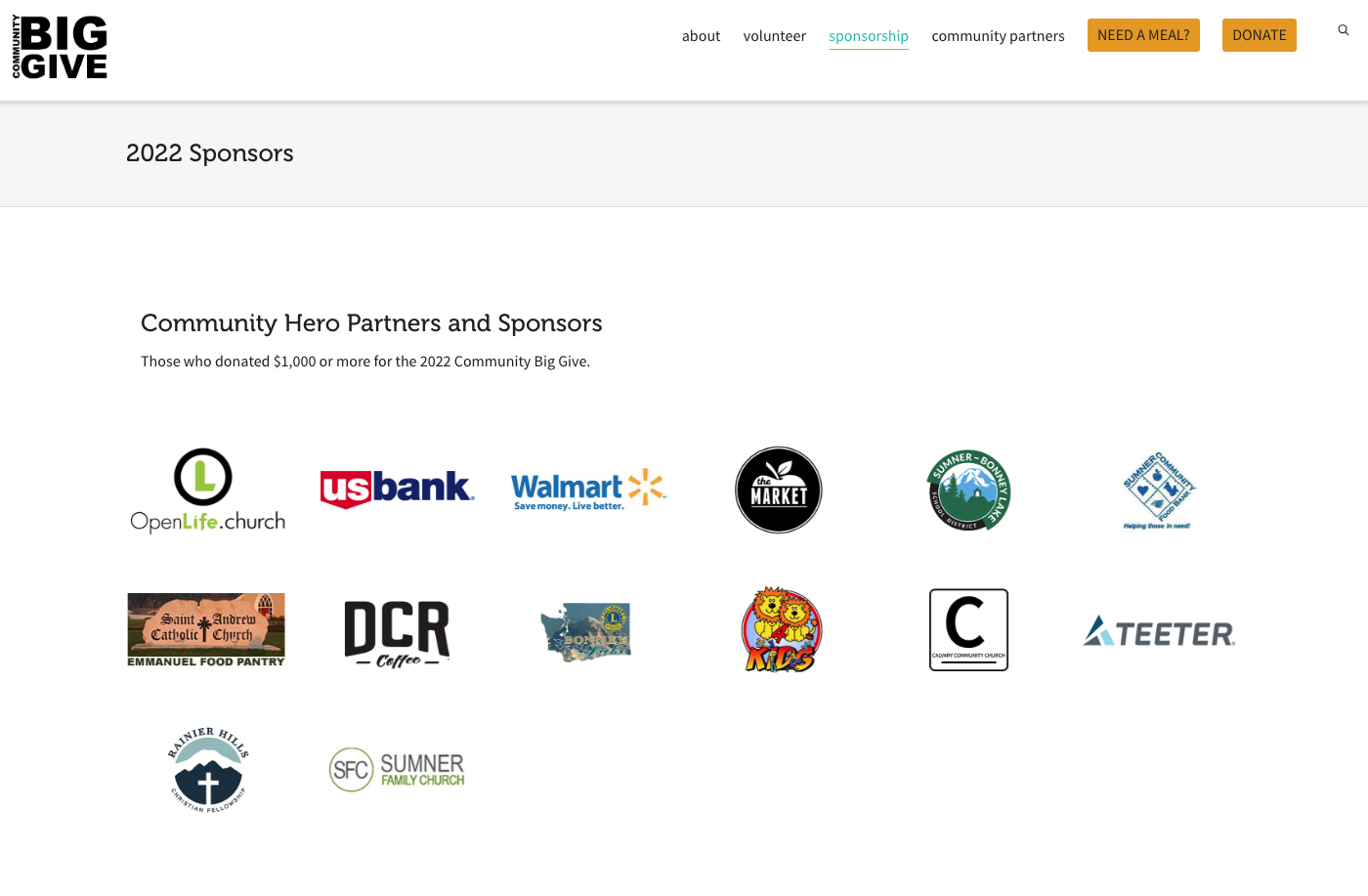
Build brand awareness and positive perceptions by sponsoring a local event or group.

Pros
- Builds brand presence in your community
- Can drives sales and traffic
- There are usually affordable options
Cons
- Not always a great ROI
- May have to say no the next time
Best For
- Cause-based local business advertising
- Building brand awareness
- Creating connections and fostering loyalty
- Getting local media coverage
- Inspiring trust and likeability
It’s common for cities and civic-based organizations to offer sponsorship opportunities as a local business advertising option. Sometimes it’s to get your brand’s logo onto a park bench (great for long-term brand awareness and advertising) or the uniforms of a local little league team.
You may also find a chance to sponsor a city event, such as food fairs and cultural festivals. Otherwise, you can participate in a civic operation like a holiday meals project or serve as a collection point for a food bank or shelter. All these opportunities are a great way to become known in your local area (for the right reasons), and it’s usually affordable for most businesses.
14. Hold a Special Event
Average cost: $500 to $1,000
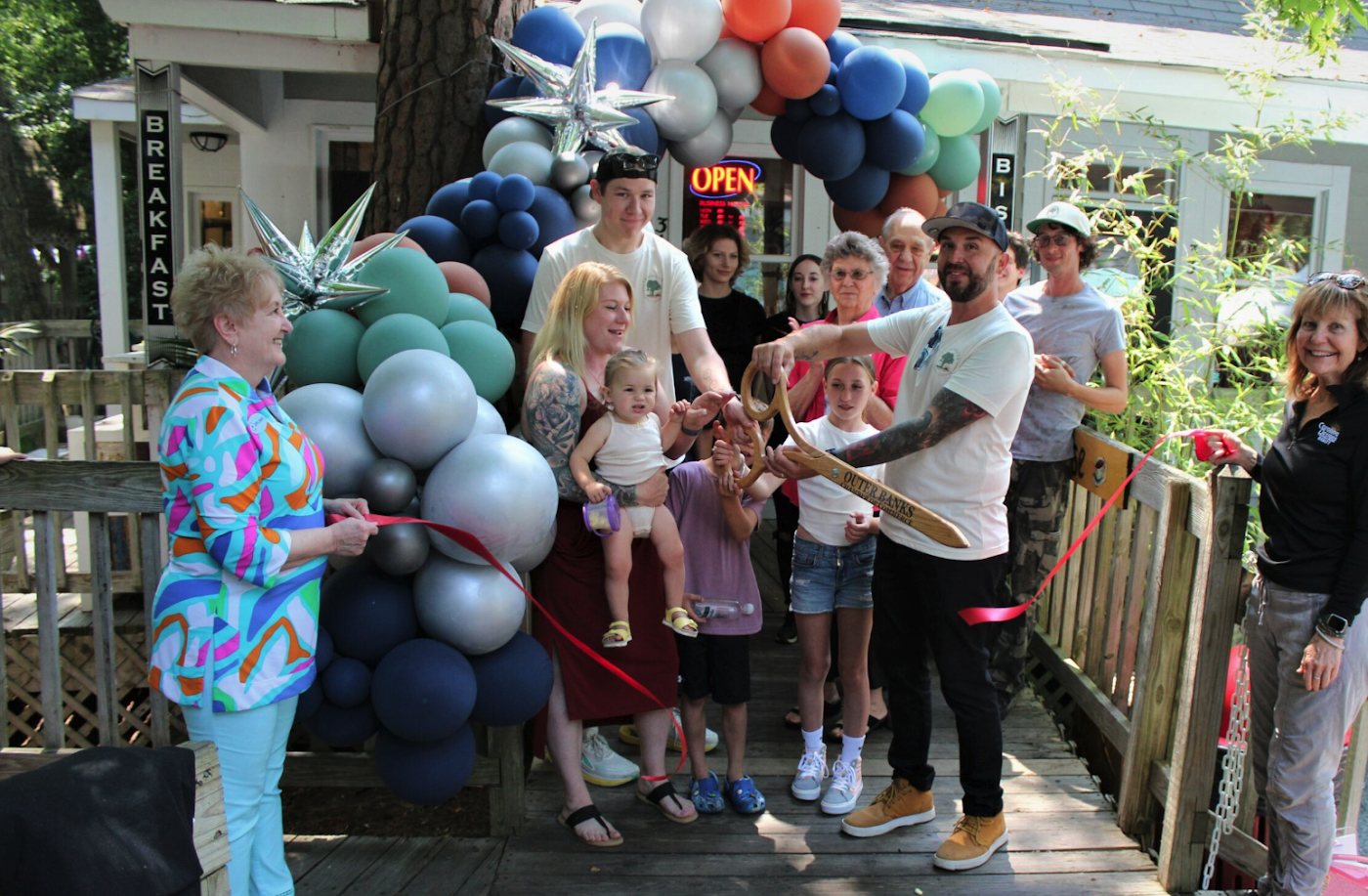
Grand opening events provide publicity for new businesses wanting to build brand awareness. (Source: Outer Banks Today)

Pros
- Builds excitement and anticipation (e.g., for a product launch or grand opening)
- Generates buzz and publicity
- Chance to build relationships with local VIPs
- Great way to educate prospects
Cons
- Risk of dismal show-up rates
- Can be expensive, depending on the venue, activities, food, and beverages, and so on
Best For
- New businesses
- Launching a major product or service innovations
- Small businesses like realtors and mortgage lenders who need to educate clients to get them to take action
- Building brand awareness
- Getting local media coverage
Hosting a launch event is a great way to market a new business or introduce new products and services to the public. A launch event can generate a lot of positive press for a business and help attract new customers and clients. Real estate agents and mortgage lenders often hold educational events as well as open houses to establish connections with residents.
Planning and hosting a successful launch event takes some careful planning and execution. Still, the payoff can be well worth the effort. If you’re thinking about launching a new product or service, consider what types of marketing materials you’ll need to publicize your event or use during the event.
15. Distribute Marketing Collateral
Average cost: $17 (100 business cards)

An example of business cards used for local business advertising

Pros
- Affordable
- Easy to carry and distribute
- Effective for coupon marketing
- Generates brand awareness
Cons
- No guarantee your materials won’t be thrown out
- Potential need to spend money on collateral design and costs can increase based on your choices (e.g., paper stock, finishes, and so on)
Best For
- Any business or professional
- Creating brand awareness
- Sharing news, coupons, discounts, promotions
- Reminding customers about your business later
Using marketing collateral like business cards, flyers, and brochures is a bit like physical display advertising. It’s one of the more basic local advertising ideas. However, it’s highly effective for increasing brand awareness and reminding customers your business exists.
It’s also an affordable way to distribute advertisements about promotions and discounts while helping with word-of-mouth advertising, such as when your customer gives your business card to a friend or co-worker. For a broad selection of marketing materials, free templates, online design tools, and affordable printing, check out VistaPrint, which tops our list of the best places to print business cards and direct mailers.
16. Reach Out to Locals by Email
Average cost: $0 to $20 per month
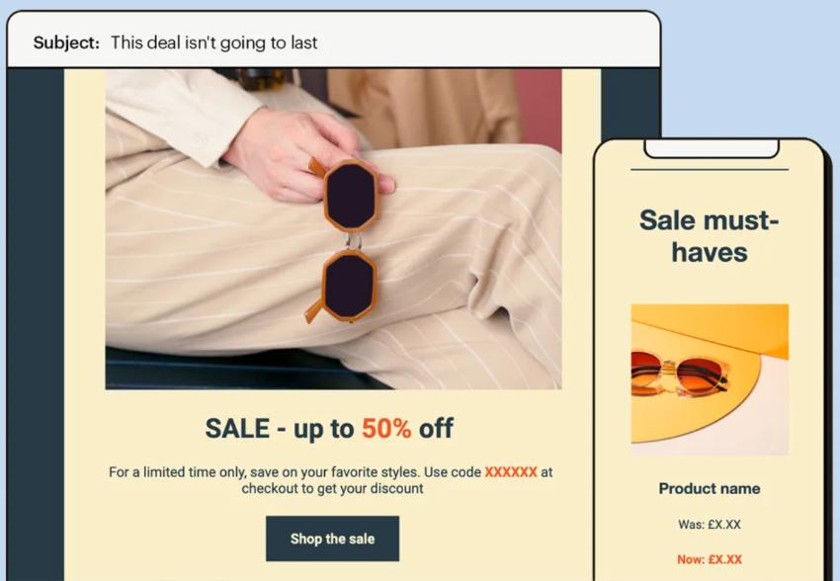
Examples of using emails to spark local business (Source: Mailchimp)

Pros
- Highly effective for most industries
- Inexpensive
- Direct contact with locals
- You control the messaging
Cons
- Need permission to use email addresses
- Building your list can take time
- Addresses provided may not be valid
- Risk of emails going to spam
Best For
- All business types
- Generating site traffic (and foot traffic)
- Promoting new products, specials, and sales
- Building brand awareness
- Customer retention and loyalty
- Requesting reviews
- Communicating news such as a change to your hours of operation or contact information
Getting special offers by email is one of the top reasons consumers subscribe to mailing lists and follow brands on social media. For this reason, email marketing is one of the top methods of small business advertising, including local advertising. To build your contact list, ask customers to sign up for emails at your store, on your website, or on your social media profiles.
If you’re new to email marketing software, we recommend using Mailchimp. It’s one of the leading email marketing platforms and packs tremendous features into all of its plans. Start for free until your list exceeds 500 contacts with free templates, campaign analytics, and tips for getting the best results from each email campaign.
17. Manage Your Online Reputation
Average cost: $30 to $100 per month
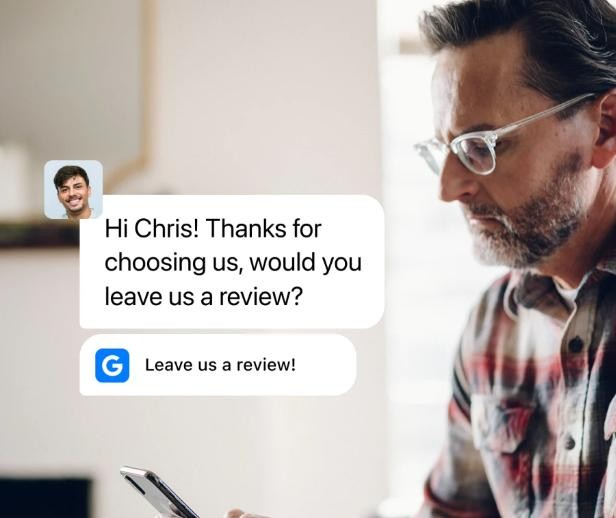
Example of local advertising ideas for reaching out for customer reviews (Source: Podium)

Pros
- Getting more reviews on Google positively impacts search rankings
- Ensures listings are accurate
- Monitors reviews and mentions to resolve potential issues quickly
- Option to use reviews as testimonials
Cons
- Depending on the services you want, can be pricey
Best For
- Any type of business
- Those wanting to monitor or respond more quickly to incoming reviews or online mentions
- Generating more online reviews
- Keeping your listings on directories consistent
What does online reputation management have to do with local advertising? Everything. Any time someone locally searches for a business in your area and industry, there’s a chance they’ll see your business’ Google profile along with your star rating, address, phone number, and hours.
A negative review (with no response from you) can be enough to drive business away. However, you can quickly get more reviews on Google using a platform like Podium, which also boosts your SEO and placement in online search rankings.
Platforms like BrightLocal give you the ability to constantly monitor your online listings. This is important because if your business listings are incorrect, you risk frustrating a potential customer who shows up after you’ve closed for the day. Find out the best local SEO tools for managing your brand’s reputation online.
18. Use Direct Mail for Local Business Advertising
Average cost: $50 to $400 per month
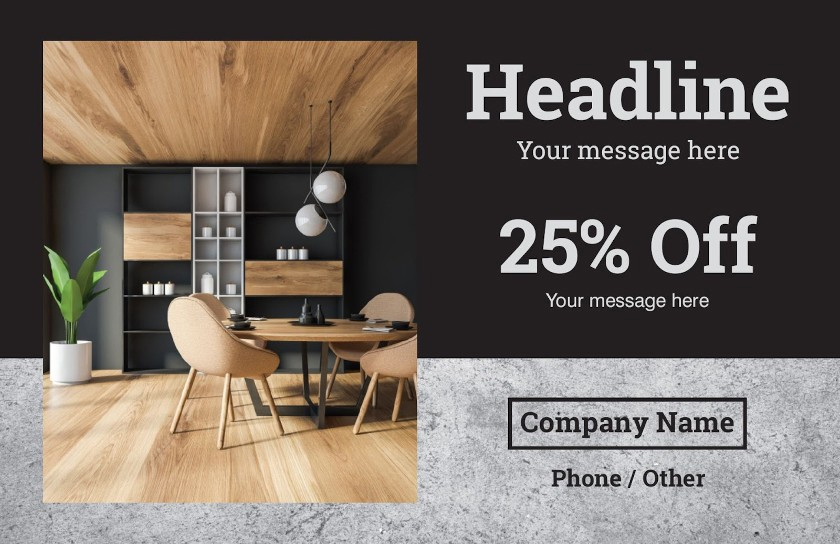
Example of local advertising ideas through direct mail (Source: Vistaprint)

Pros
- Effective for most industries
- Target by demographics or to every door in a ZIP code or city
- Affordable, cost-effective, and scalable
- A great alternative or addition to digital ads
- Results are easy to measure
Cons
- Costs increase when postage rates go up
- Risk of low response rate
Best For
- All types of local business advertising
- Bringing customers to your business or website
- Promoting new products, specials, and sales
- Building brand awareness
- Customer retention and reviving lapsed patrons
- Communicating business news
Direct mail is one of the local advertising ideas that allows you to target a specific audience with laser precision or reach a broad audience. A quick review of the best business postcard examples, for example, shows they are a highly visual marketing tool that can convey your messages in a short, eye-catching way.
To get started, read our guide explaining what direct mail marketing is and how it works. It shows examples for differerent types of campaigns and will give you a better understanding of all the ways you can use it to reach your audience.
Control who receives your mailings by targeting specific demographics, interests, or even past purchasers for a higher return on spend. Alternatively, you can use the Every Door Direct Mail (EDDM) service to deliver marketing materials to every mailbox in a defined geographic area. See which are the best direct mail services for small businesses based on overall value, ease of editing, niche features, quality, and cost.
19. Attract Window Shoppers With Digital Signage
Average cost: $59 per month
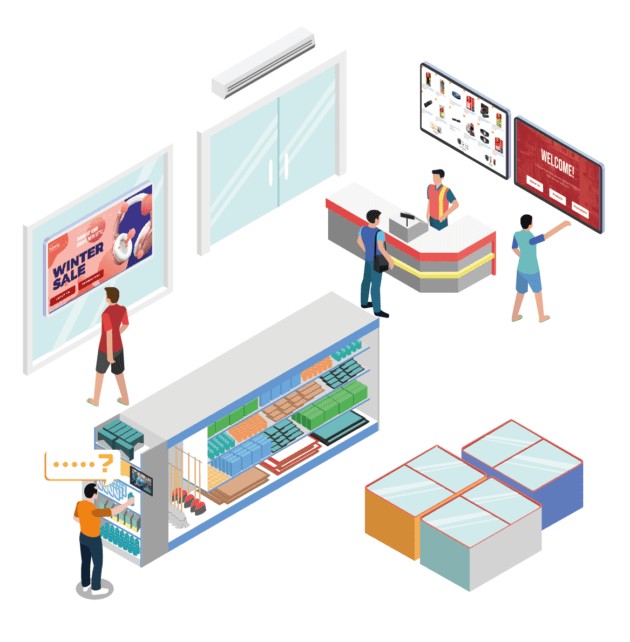
Examples of local advertising ideas using digital signs (Source: Raydiant)

Pros
- Easy to set up and affordable
- You control the content
- Attracts passersby
- Ability to change content often
Cons
- Technology and equipment can get expensive
- Won’t work if the power goes out
- May require maintenance and upgrades
Best For
- Retail shops
- Salons and spas
- Medical practices and clinics
- Restaurants, coffee shops, and bars
- Event centers
- Gyms and fitness centers
Your storefront and interior can be a giant billboard for “free” local business advertising using digital signs. Digital signage is eye-catching and memorable. Plus, it’s easier to display more information with a digital sign, and you can change the content anytime. For example, digital restaurant menus can be used to display items and prices or daily specials, upcoming events, and other important information.
20. Collaborate With Fellow Local Businesses
Average cost: Free

Pros
- Little to no cost to collaborate
- Benefits both businesses
- Introduces your business to an expanded audience
Cons
- Can be challenging to find businesses that want to collaborate
- Requires time and resources to plan and execute campaigns effectively
Best For
- Retailers
- Restaurants and cafes
- Bakeries
- Service-based industries or professionals (e.g., real estate and mortgage lending agents)
Among the essentially free local marketing ideas on this list is to collaborate with other businesses on marketing and ad campaigns. For example, if you own a bakery, you could work with a local coffee shop. You could brew and sell the cafe’s coffee, and they can sell your pastries.
Photographers and florists can hook up with event centers, real estate agents and mortgage lenders can collaborate, a graphic designer would work well with a local print shop, and so on. Collaboration can also be as simple as referral marketing—check out our list of the best referral lead generation sources by industry.
21. Give Back to Your Local Community
Average cost: Free

Community givebacks are an effective tool for generating brand awareness and positive brand perceptions.

Pros
- Demonstrates your commitment to the local community
- Creates a positive brand image
- Potential to get local news coverage
- Tax write-offs for time and products
Cons
- Can negatively impact revenue and profitability during the give-back
Best For
- Any local business
- Giving back to your community
- Building brand awareness
- Creating loyalty and a positive reputation
Community members tend to remember the businesses that get involved and donate time or services to help improve the local area. For example, a barbershop or salon might offer free haircuts for veterans one day each quarter or treat a local hero to a makeover.
Local businesses that give back to their community often get a big return on the investment in customer loyalty—not to mention knowing they’re positively impacting the local community. If you’ve wanted to do this but weren’t sure where to start, find local nonprofit organizations that are relevant to your business to give back to your local community.
22. Join the Chamber of Commerce
Average cost: $300 to $500 per year

Pros
- Most chambers are affordable to join
- Many offer benefits beyond marketing, such as professional development workshops and more
- Joining the local chamber improves your reputation in the local marketplace
Cons
- Membership can become a time suck, especially if you like to get involved
- Cost is based on business size, so can be pricey if your company has a lot of employees
- May not produce leads or sales
Best For
- Any small business that engages in commerce locally
- New businesses looking to establish themselves quickly
One often overlooked part of developing a local marketing strategy is joining local professional and community organizations that align with your business goals. One such organization is your local Chamber of Commerce. The Chamber, as it is almost universally known, is an association of local businesses and leaders that engages in a host of activities to benefit the local economy.
In addition to helping build your brand presence through name recognition and networking, the Chamber is also a great resource for business development. Many local Chambers of Commerce host professional and business development workshops. Some even provide business mentorship opportunities to help you grow professionally.
23. Become BBB Accredited
Average cost: $510 to $1,225 per year

Local listings for BBB-accredited lawn care in the Seattle area (Source: BBB)

Pros
- BBB is universally recognized for its reputation
- Dispute resolution is part of BBB’s accreditation and reporting system
Cons
- Membership fee is based on the number of employees and increases as your business grows (can be pricey)
Best For
- Any small business that engages in commerce locally
- New businesses looking to establish themselves quickly
The Better Business Bureau (BBB) is another local business organization you should consider joining. Once you’ve joined, you should work to become a BBB-accredited business. Not only does BBB accreditation tell your customers that you’re trustworthy, but it also gains you listing in their local service directories and accreditation site.
Many customers turn to the BBB to find the right local business for their needs. Additionally, you can display accreditation status to your customers on your website, your store window, lobby, and more. It lets them know your business is trustworthy, reliable, and stands behind the products and services you offer.
24. Join the Tourism Bureau
Average cost: $100 to $500 per year

Pros
- Most CVBs point visitors in the direction of member businesses
- Membership is usually inexpensive
Cons
- It may be difficult to track or even estimate ROI
Best For
- Restaurants
- Night clubs
- Bed and breakfasts
- Hotels and motels
- Entertainment businesses
Another organization many businesses should consider is your local tourist organization, such as the convention and visitors bureau (CVB). Joining the CVB makes sense for some businesses that are either dependent upon or adjacent to tourism. This includes restaurants, local hotels, bed and breakfasts, and more.
One of the CVB’s jobs is to point visitors to your region in the direction of local businesses and attractions, so being a member makes sense for hospitality businesses. Also, many independent retailers support local tourism bureaus to bolster foot traffic to the retail shopping areas of their communities.
25. Get a Vehicle Wrapped
Average cost: $2,000 to $4,500
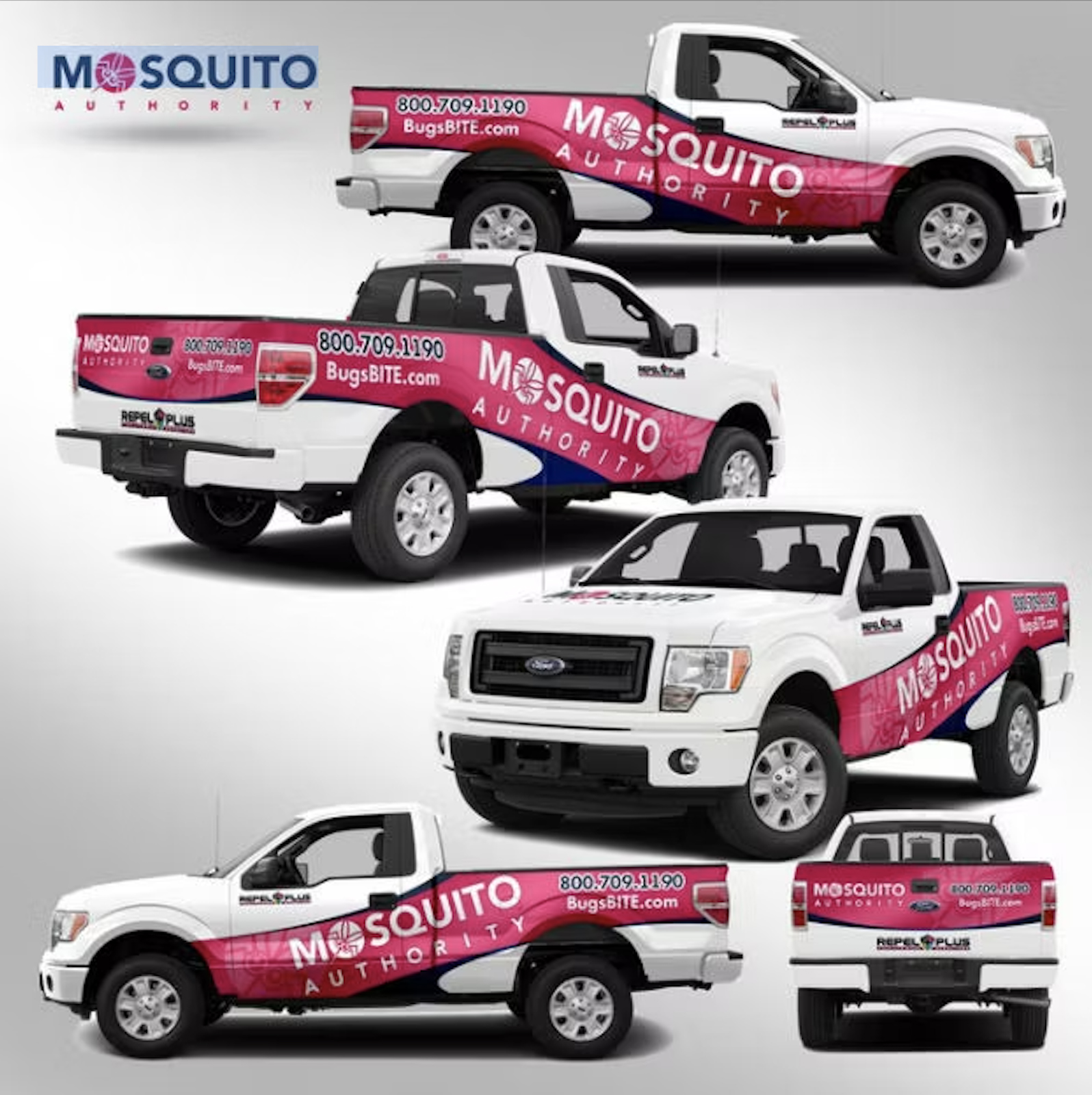
A wrapped truck for a mosquito abatement company (Source: 99designs)

Pros
- High visibility, mobile advertising
- Room for multiple sales messages and calls to action
- Durable, long-term investment
Cons
- Conversion rates are lower
- May lower value of vehicle
Best For
- Landscapers
- Contractors
- Attorneys
- Service-based businesses that travel to customer location
Wrapped vehicle advertising involves the professional installation of a thin sheet of vinyl to your work automobile. The vinyl has been printed with visually engaging graphics, images, and messages. Chances are, you’ve seen a vinyl-wrapped vehicle while driving down the road or stopped at a traffic light.
Mobile ads like vehicle wraps generate 2.5 times the attention of static ads, making vehicle wraps a very effective marketing tool, according to Intuit QuickBooks. Vehicle wraps connect your brand to potential customers while you’re driving from job to job. They’re effective because they’re “always on” advertising that uses a resource you already have—your vehicle—to display the advertising.
26. Advertise on Mass Transit
Average cost: $150 to $3,000

Pros
- Mobile advertising is highly visible and effective
- Cost-per-impression (CPI) is very low
Cons
- Can become expensive in larger municipalities
- Difficult to track ROI
Best For
- Attorneys
- Medical providers
- Service-based businesses
- Special events
- Larger retail businesses
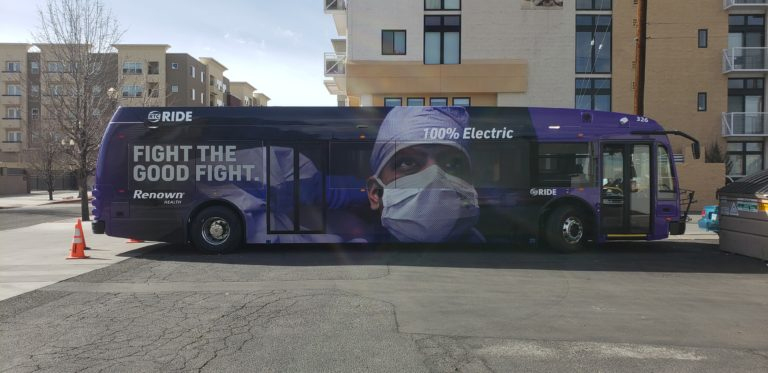
An ad for a healthcare provider on the side of a bus (Source: RTC of Washoe)
You may think mass transit advertising is limited to the big ads on the sides of city buses or commuter trains, but there is a lot more to mass transit advertising. There are display ads at bus stops and once passengers have boarded the bus, as well. In fact, mass transit advertising is one of the most cost-effective forms of advertising available.
According to Vector Media, transit advertising is the cheapest form of advertising when measuring cost per 1,000 impressions (CPM). Just think of how many people see the side of a city bus over the course of a day or pass by that bus stop during rush hour. Mass transit advertising is a great way to put your brand top of mind when potential customers start looking for a business in your industry.
27. Sign Up for Restroom Ads
Average cost: $150 to $600
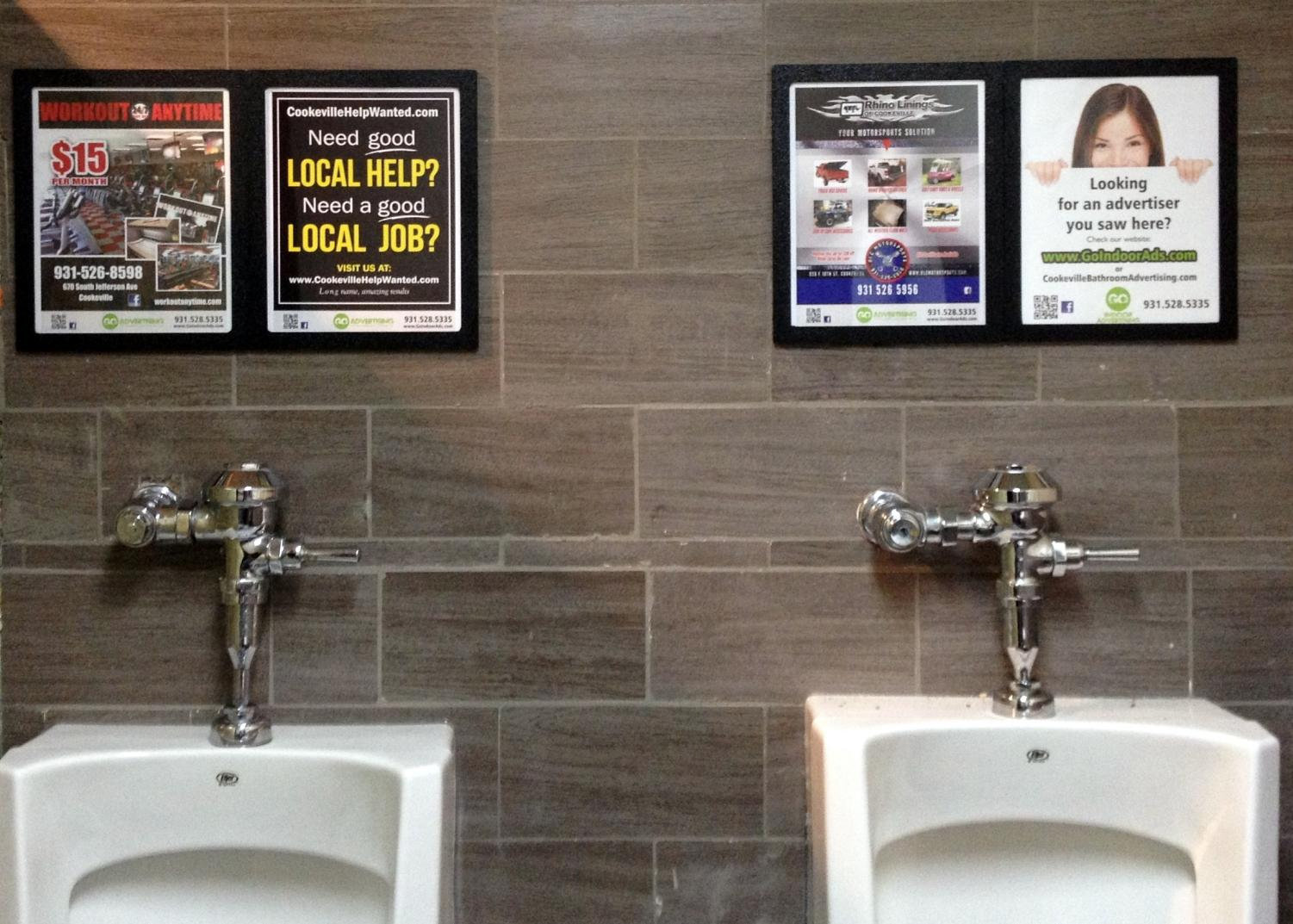
Advertisements over urinals in a men’s restroom (Source: Spectator News)

Pros
- High-traffic, low CPM advertising
- Advertising to a “captive” audience
Cons
- Can be considered lower-brow than other forms of advertising
Best For
- Hair salons and barbers
- Local restaurants or nightclubs
- Recreational activities such as boating rentals or campgrounds
Restroom advertising is a unique form of display advertising in which small plaques or posters are installed in restrooms at restaurants, sports arenas, nightclubs, shopping malls, and more. These advertisements are placed so they’re visible while patrons utilize the facilities, meaning your advertisement is being displayed to a captive audience.
These ads are effective because patrons typically view the ad multiple times over a single visit to the restroom, and they tend to commit details of well-designed ads to memory. Evidence suggests it’s also highly memorable. An American Restaurant Association study found that 78% of visitors could recall details about specific ads in the restrooms they visited.
Frequently Asked Questions (FAQs)
Local advertising is the promotion of a business within a specific location, such as a city or county. Local business advertising often includes TV, radio, and newspaper ads—and also extends to word-of-mouth marketing, social media, paid search ads, and distribution of marketing materials, like business cards.
Several different types of local advertising ideas will work to attract local customers—direct mail, email marketing, social media ads, Google ads, and local SEO. Coupon marketing is an especially popular method of attracting new customers through time-limited discounts or gift-with-purchase deals.
There are several free local advertising options for small businesses on a budget. For example, email marketing is free to start with using Mailchimp. Posting on social media, setting up your Google and Bing business listings, and creating content for your website doesn’t cost anything but time. If you do have a little bit to spend on ads, social media advertising is a great place to start.
Bottom Line
No matter whether your budget to execute local advertising ideas is a lot or none at all, you can use many, if not all, of the ideas above to promote your business locally. For the best results, use a combination of local business advertising strategies, such as email marketing, social media, local business collaborations, and rewards programs, and track your results for each. As a result, you will generate brand awareness and gain new customers quickly.